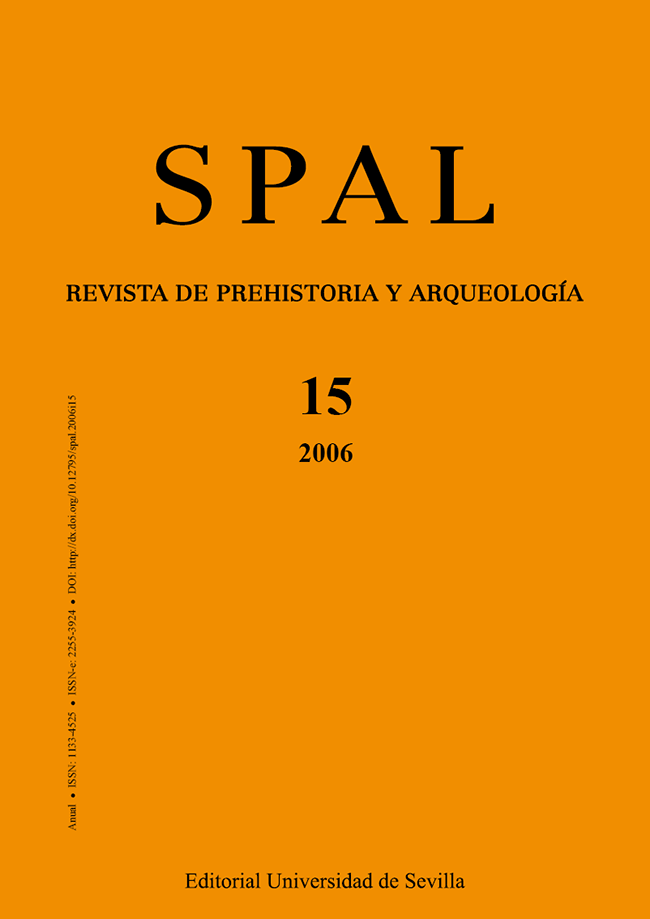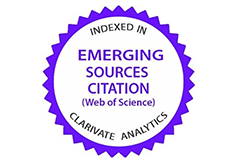La etnicidad como un arma ideológico-religiosa en la antigua Grecia: el caso del Monte Liceo
DOI:
https://doi.org/10.12795/spal.2006.i15.09Palabras clave:
Identidad, Etnicidad, Monte Liceo, Megalópolis, ArcadiaResumen
La identidad es una forma de autodefinición necesaria para la constitución de cualquier grupo humano. Algunas sociedades necesitan llevar más allá sus procesos identitarios desarrollando, a través de poderes políticos consolidados, sentimientos étnicos de mayor calado ideológico que los identitarios. El paso de la identidad a la etnicidad no es ni obligado ni sencillo, como ilustra el ejemplo elegido, el Monte Liceo, en Arcadia, claro exponente de la fuerza ideológica que alcanzan las definiciones identitarias y los procesos de construcción étnica.
Descargas
Citas
ALTY, J. (1982): “Dorians and Ionians”, JHS 102: 1-14.
ANDERSON, B. (1991): Imagined communities: reflections in the origins and spread of nationalism, London.
BARTH, F. (ed.) (1976): Los grupos étnicos y sus fronteras, México.
BEAZLEY, J. D. (1978): Attic Black-Figure Vase-Painters, New York.
— (1968): Attic Red-Figure Vase-Painters, London.
BOARDMAN, J. (1997a): “Pan”, en LIMC VIII (1) y VIII (2): 923-941 y 612-635. Paris.
— (1997b): The Great God Pan: the survival of an image (Walter Neurath Memorial Lecture 1997), London.
BORGEAUD, P. (1979): Recherches sur le dieu Pan, Genève.
BRADLEY, R. (1991): “Monuments and places” en GARWOOD, P., JENNINGS, D., SKEATES, R. and TOMS, J. (eds.), Sacred and profane: 135-140. Oxford.
BRIANT, O. (1989): “Histoire et idéologie. Les Grecs et la “décadence perse” en MACTOUX, M. M. et GENY, E. (eds.), Mélanges Pierre Lévêque 2. Anthropologie et société : 33-47. Paris.
BURKERT, W. (1983): Homo Necans: the anthropology of Ancient Greek sacrificial ritual and myth, Los Angeles.
BUXTON, R. G. A. (2000): El imaginario griego: los contextos de la mitología, Madrid.
CARDETE DEL OLMO, M. C. (2005a): Paisajes mentales y religiosos: la frontera suroeste arcadia en épocas arcaica y clásica, Oxford.
— (2005b): “La polis como articulación social: el caso arcadio”, Gerión 23 (1): 81-99.
— (2004a): “La construcción de un mito: el encuentro entre Pan y Filípides en el Partenio”, en HERNÁNDEZ GUERRA, L. y ALVAR EZQUERRA, J. (eds.), Actas del XXVII Congreso Internacional GIREA-ARYS IX, Jerarquías religiosas y control social en el mundo antiguo, Valladolid 7-9 Noviembre 2002: 215-222. Valladolid.
— (2004b): “Ethnos y etnicidad en la Grecia clásica”, en CRUZ ANDREOTTI, G. y MORA SERRANO, B. (eds.), Identidades étnicas-identidades políticas en el mundo prerromano hispano: 17-29. Málaga.
— (1993): “Identidad y religión: el santuario de Apolo en Basas”, Studia Historica, Historia Antigua 21: 47-74.
CARTLEDGE, P. (1993): The Greeks: a portrait of self and others, Oxford.
DOW, S. (1937): “Athenian Decrees of 216-212 B. C.”, HSCP 48: 120-126.
DUKE, P. (1998): “Ethnicity: past and present”, Cambridge Archaeological Journal, 8 (1): 119-121.
EIDHEIM, H. (1976): “When ethnic identity is a social stigma”, en BARTH, F. (ed.), Los grupos étnicos y sus fronteras: 50-74. México.
EMBERLING, G. (1997): “Ethnicity in complex societies: archaeological perspectives”, Journal of Archaeological Research 5 (4): 295-344.
ERIKSEN, T. H. (1993): Ethnicity and nationalism. Anthropological perspectives, London.
FOUGÈRES, G. (1898) : Mantinée et l´Arcadie orientale, Paris.
— (1904): “Lykaia”, DA: 1432-1437.
HALL, E. (1989): Inventing the barbarian. Greek self-definition through tragedy, Oxford.
HALL, J. M. (2002): Hellenicity. Between ethnicity and culture, London.
— (1998): “Discourse and praxis: ethnicity and culture in Ancient Greece”, Cambridge Archaeological Journal 8 (2): 266-269.
— (1997): Ethnic identity in Greek antiquity, Cambridge.
— (1995): “Approaches to ethnicity in the early Iron Age of Greece”, en SPENCER, N. (ed.) Time, tradition and society in Greek archaeology. Bridging the “Great Divide”: 6-17. London.
HARTOG, F. (1980): Le miroir d´Hérodote: essai sur la representation de l´autre, Paris.
HEJNIC, J. (1961): Pausanias the perieget and the archaic history of Arcadia, Praga.
HILD, J. A. (1904): “Pan”, DA: 296-302.
HUGHES, D. (1986): Human sacrifice in Ancient Greece (D. Phil. Thesis), Ohio.
HUNTINGTON, S. P. (1997): El choque de civilizaciones y la reconfiguración del orden mundial, Barcelona.
JENKINS, R. (1997): Rethinking ethnicity: arguments and explorations, London.
JONES, S. (1998): “Ethnic identity as discursive strategy: the case of the Ancient Greeks”, Cambridge Archaeological Journal 8 (2): 271-273.
— (1997): The archaeology of ethnicity: constructing identities in the past and in the present, London.
JONES, S. and GRAVES-BROWN, P. (1996): “Introduction. Archaeology and cultural identity in Europe”, en GRAVES-BROWN, P., GAMBLE, C. and JONES, S. (eds.), Cultural identity and Archaeology: the construction of European communities: 1-24. London.
JOST, M. (1985): Sanctuaries et cultes d´Arcadie, Paris.
— (1994): “The distribution of sanctuaries in civic space in Arkadia”, en ALCOCK, S. and OSBORNE, R. (eds.), Placing the gods. Sanctuaries and sacred space in Ancient Greece: 216-230. Oxford.
— (1999): “Les schémas de peuplement de l´Arcadie aux époques archaïque et classique”, en NIELSEN, T. H. and ROY, J. (eds.), Defining Ancient Arkadia, Symposium April 1-4, 1998, Acts of the Copenhagen Polis Centre, Vol. 6: 192-247. Copenhagen.
JOST, M.; CASEVITZ, M. et MARCADÉ, J. (ed., trad. y notas) (1998): Pausanias. Description de la Grèce, Tome VIII, Livre VIII, L´Arcadie.
KOUROUNIOTIS, K. (1909): “Ανασκαϕαιῃ Λυκαιῃου”, PAE: 185-200.
LÉVY, E. (1984): “Naissance du concept de barbare”, Ktema 9: 5-14.
MALKIN, I. (1998): The returns of Odysseus: colonization and ethnicity, Berkeley.
MOGGI, M. e OSANNA, M. (ed., trad. y notas) (2003): Pausania. Guida della Grecia. Libro VIII. L´Arcadia, Milano.
MORETTI, L. (1957): Olympionikai. I vincitori negli antichi agoni olimpici, Roma.
MORGAN, C. (1997): “The archaeology of sanctuaries in Early Iron Age and archaic ethne. A preliminary view”, en MITCHELL, L. and RODHES, P. J. (eds.), The development of the polis in Archaic Greece: 168-198. London.
— (1991-1992): “Ethnicity and early Greek states: historical and material perspectives”, Proceedings of the Cambridge Philological Studies 37: 131-163.
MORRIS, I. (1998): “Words and things”, Cambridge Archaeological Journal 8 (2): 269-270.
NIELSEN, T. H. (1996a): “A survey of dependant poleis in classical Arkadia”, en HANSEN, M. H. and RAAFLAUB, K. (eds.), More studies in the ancient Greek polis, Papers from the Copenhagen Polis Centre 3: 63-105. Stuttgart.
— (1996b): “Arkadia. City-ethnics and tribalism”, en HANSEN. M. H. (ed.), Introduction to an inventory of Polis, Acts of Copenhagen Polis Centre 3: 117-163.
— (1996c): “Was there an Arkadian confederacy in the fifth century B.C.?”, en HANSEN, M. H. and RAAFLAUB, K. (eds.), More studies in the ancient Greek polis, Papers from the Copenhagen Polis Centre 3: 39-61. Stuttgart.
— (1997): “Triphylia. An experiment in ethnic construction and political organisation”, en NIELSEN, T. H. (ed.) Yet more studies in the Ancient Greek polis, Papers from the Copenhagen Polis Centre: 129-162. Stuttgart.
— (1999): “The concept of Arkadia- the people, their land and their organisation”, en NIELSEN, T. H. and ROY, J. (eds.), Defining Ancient Arkadia, Acts of the Copenhagen Polis Centre 6: 16-88. Copenhagen.
— (2002): Arkadia and its poleis in the Archaic and Classical Periods, Göttingen.
NIELSEN, T.H. y ROY, J. (1998): “The Azanians of northern Arkadia”, Classica et mediaevalia 2: 5-44.
OVENSEN, J. (1983): “Man or beast? Lycanthropy in the Naga Hills”, Ethnos 1-2: 5-25.
PASCUAL GONZÁLEZ, J. (2001): “Identidades y fronteras en Grecia central”, en LÓPEZ BARJA, P. y REBOREDA MORILLO, S. (eds.), Fronteras e identidad en el mundo griego antiguo, III Reunión de Historiadores: 241-263. Santiago de Compostela-Vigo.
PARK, Ch. C. (1994): Sacred worlds: an introduction to geography and religion, London.
POLIGNAC, F. de (1984): La naissance de la cité grecque, Paris.
PRONTERA, F. (2003): Otra forma de mirar el espacio: Geografía e Historia en la Grecia antigua, Málaga.
RENFREW, C. (1998): “From here to ethnicity”, Cambridge Archaeological Journal 8 (2): 275-277.
RENFREW, C. y MESKELL, L. (2001): “From social to cognitive archaeology: an interview with Colin Renfrew”, Journal of Social Archaeology, 1 (1): 13-34.
ROY, J. (1972): “Tribalism in Southwestern Arcadia in the Classical Period”, Acta Antiqua Academiae Scientiarum Hungaricae 20: 43-51.
SHENNAN, S. J. (ed.) (1994): Archaeological approaches to cultural identity, London.
SIAPKAS, J. (2003): Heterological ethnicity: conceptualizing identities in ancient Greece, Uppsala.
SMITH, A. D. (2000): The nation in history. Historiographical debates about ethnicity and nationalism, Oxford.
— (1986): The ethnic origins of nations, Oxford.
TILLEY, Ch. (1994): A phenomenology of landscapes. Places, paths and monuments, Oxford.
WILLIAMS, R. T. (1965): The Confederate Coinage of the Arcadians in the fifth century B. C., New York.
Publicado
Cómo citar
Número
Sección
Licencia
Derechos de autor 2020 SPAL - Revista de Prehistoria y Arqueología

Esta obra está bajo una licencia internacional Creative Commons Atribución-NoComercial-SinDerivadas 4.0.









